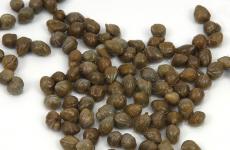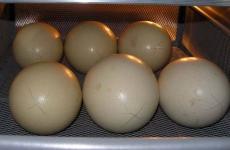Crochet curtains for the kitchen. Knitted curtains
Knitted curtains for the cottage are a cozy and decorative element in the house.
———————-
You will need 100 grams of white yarn and a hook.
The pattern is knitted with fillet mesh.
And I bring to your attention one more option. This is a small curtain with butterflies.
You choose the length of the curtain yourself. Cast on 109 loops (54 squares*2+1) and knit the required number of repeats according to the pattern.
To make the pattern look good from a short distance, it is better to make the cells small: empty cell = 1 double crochet, 1 chain stitch; filled square = 2 double crochets.
Now your country house will be cute and homely. Photos and diagrams from the magazine were used
Yes, knitted curtains for the kitchen are not the most practical option. But perhaps we are losing something in our lives by being guided only by practicality?
Almost all of us know how to knit. At least that's what we were taught at school. How long have you been knitting and for whom? But this is real homemade creativity.


I don’t think that before our great-grandmothers were less busy with housework than we were, but they managed to sew and embroider beautiful things for their home.
No matter how impractical the idea may seem - with a variety of ready-made curtains for the kitchen, tying curtains for the kitchen with your own hands, such work will have a beneficial effect on your general psycho-emotional state.


Even work on the largest curtain has its end if you knit two or three motifs a day.
A mysterious and interesting play of light and shadow is characteristic of curtains made using the fillet knitting technique.


Such a cute curtain with a floral pattern will be a harmonious decoration for your kitchen window,
Before knitting the border, be sure to wash the curtain fabric so that it gives the necessary shrinkage, and then calculate the length of the knitted border.

This semicircular curtain for a kitchen window is crocheted based on the motifs for a round napkin.

Kitchen curtains made using the fillet knitting technique are especially beautiful.
Knitted curtains for the kitchen are a triumph of the long and painstaking work of the needlewoman. Such curtains can be made using different techniques, but they always give the kitchen a special coziness and well-groomed look.



A selection from the Internet.
Every housewife wonders how to beautifully decorate her home and create a special atmosphere and comfort. This is exactly the kind of environment that knitted curtains will create. They look great on window and door openings. This article also presents ready-made patterns for crocheted curtains.
The advantage of knitted curtains is that you can make them yourself. In addition, in hardware stores you will find a wide range of knitted curtains of rectangular and other shapes with various designs and patterns. Knitted curtains look original and create a feeling of harmony in the home.






Photo - 8 White interior curtains

Photo - 9 Curtain with tassels

The DIY option has the following advantages:
- saving money - you will only spend money on consumables for manufacturing;
- unique design - develop your own curtain model;
- the ability to choose the desired thread color that will fit into the created interior.
Interesting! Psychologists have proven that crocheting promotes relaxation and stress relief. In addition, you can take your mind off existing problems. Therefore, crocheting curtains is a great way to relax.
If you don’t know how to knit an exclusive curtain, for example watch the video:
Curtain crochet techniques
Of course, for many, the ideal option is to purchase already knitted curtains. But if you are a creative person, value uniqueness and want to make your own future curtain, you need to decide on the patterns and take the appropriate measurements.
To make a curtain for a window or door, use one of the following techniques:
- sirloin - chosen by beginners, a special canvas of empty and filled cells is used;





- Irish - formed from elements in the same style - flowers, stems, leaves. Before starting work, prepare diagrams and descriptions of this equipment;
- Bruges – the basis is a mesh with a striped braid based on the selected motifs;
- brumstick – knitting and crocheting.
For the fillet technique or bruges, you should purchase a special canvas with a description and diagrams for making patterns. If you wish, complement the curtain with beads or crocheted pendants, which is important when making curtains for doorways.
Advice! If you don't feel inspired to make a large piece, you can add a knitted border or tiebacks to an existing piece.




Curtain using fillet knitting technique
If you're just beginning to crochet, try a simple fillet border on a finished curtain.
Cast on the required number of air loops with a length slightly larger than the existing product from one ball, take another ball with threads of a different color and knit the first row. From the beginning of the dialed chain. Get to the end of the row, try on, tie or unravel the chain of air loops.
Follow the diagram and at the beginning of each row change the first stitch to 3 chain loops:
- 1 – 10 empty cells and 2 filled;
- 2 – 8 empty cells and 4 filled;
- 3 – 6 empty cells and 6 filled;
- 4 – 4 empty cells and 8 filled ones.
We connect the resulting rings in one row, sew them to the fillet border and sew them onto the curtain.




Knitted curtains for the kitchen

Photo - 26 Curtain in the kitchen







Photo - 35 Narrow curtain with an interesting pattern
Since ancient times, our grandmothers have knitted curtains for the hallway and kitchen. There are many different schemes on the Internet.
But for many housewives, the question remains: how to tie a curtain holder and various curtain ties? This will be useful for a kitchen that has long curtains at the entrance. Watch the video and you will quickly learn how to make crochet tiebacks and beautifully tie such curtains.
Two more examples of original bright curtain hooks:

Photo - 37 Tiebacks in the form of crocheted monkeys for the children's room
Below you can view photos of several more original and creative solutions for knitted curtains.

Photo - 43 Knitted lambrequin with pendants. Author
There are threads made from mixed fibers: natural and synthetic. Products made from such materials are durable and hold their shape well.
Choosing a hook for knitting curtains
In order for the finished product to turn out smooth and beautiful, it is important to choose the right knitting tool. For thick and dense thread, select a hook with a large diameter corresponding to the yarn. For a thin thread, use a small-diameter hook or knitting needles.
Hooks come in plastic (for thick wool or acrylic threads) and metal (for thin natural fibers).
Color selection
When choosing the color of future curtains, you need to focus on your own taste and the interior of your home, the size of the window and the room in which the curtains will be located.
Curtains made of white and light threads are suitable for small rooms with small windows. Visually expand the space, create a feeling of freshness and cleanliness. Suitable for both strict classical style and touching rustic or romantic.
In a rustic style, muted natural shades of blue, green and lilac are appropriate.
Contrasting curtains of bright colors should match the interior items and harmonize with it, so as not to attract unnecessary attention and be appropriate in the room.

Patterns
There are many different patterns to choose from, so it's easy to choose one that you like and matches the style of your home. And a self-invented ornament will turn your curtain into a designer art object.
You can choose a repeating pattern. This is a simple and easy to implement option. Suitable for any interior. Build entire storylines with pictures of nature (for example, for a rustic style), experiment with color. Curtains look beautiful when assembled from different motifs into a single whole. Sweet cats, butterflies, and angels will add coziness to your home environment.
If you want the curtain to let in a lot of light, choose a pattern with large spaces between the main elements. Add fringe to short curtains.
How to calculate the amount of yarn
It's not very pleasant when the threads run out at the most inopportune moment. Therefore, before starting work, be sure to calculate the amount of yarn for your hand-knitted product.
To do this, you need:
- knit a sample - a fragment of the main pattern (it can be a square with sides of 10 cm);
- wash, dry and iron the sample;
- unravel to measure the length of the thread that went into making it;
- measure the window or doorway to determine the size of the curtain;
- calculate the amount of yarn using the data obtained.
When calculating yarn, you need to keep in mind that yarn made from natural fibers loses 5 to 10% of its weight after washing.

Choosing a design for different rooms
Each room in an apartment or house carries its own meaning and has a different purpose. Therefore, the design of the curtains should be different. It is important to take into account the direction of the world where the room is located. Rooms located on the south side need a long, tightly knitted fabric that diffuses the direct rays of the sun.
For a kitchen or other non-residential room
Curtains for the kitchen should not only be beautiful, but also practical. Any space in the kitchen can be used as a work surface. This also applies to window sills. Therefore, a better option is a curtain that covers only part of the window. The product will be washed frequently, so the knitting density and quality of the yarn must be appropriate in order to maintain a pleasant appearance longer. The edges curtains for the kitchen be in the form of leaves or flowers. The bottom is straight or rounded, with tassels and fringe.

For the bedroom
Curtains with a complex compositional pattern, falling almost to the floor, will look great in the bedroom. Motifs in the French style, where the canvas is slightly gathered in folds and decorated with fringe or tassels, will fit very harmoniously into the decor.
It is better to knit volumetric curtains from two fabrics, connecting in the middle, which will provide convenient access to the window or balcony. It is allowed to use two or more canvases of different colors. For example, a lighter curtain in close proximity to the window, then a darker one further away.

For children's
Curtains with animals, trees, and fairy-tale characters made using the fillet knitting technique will look great here. In this case, the details of the pattern are knitted more tightly, which makes it possible to do without night curtains.

Knitting technique
Crocheting is a fairly simple type of needlework that originates from antiquity. Any product begins from a chain of air loops, and the pattern is made up of sequentially located half-columns and columns with one or more crochets. You just need to carefully follow the diagrams that come with each product.
There are several techniques that are most often used.
Sirloin
A technique loved by many craftswomen. The pattern is knitted on the fabric in the form of a fillet mesh by alternating empty and filled (double crochets and chain stitches) cells. From such “filled” cells entire paintings are created on the canvas. The pattern is formed both along and across.
Products using the fillet technique can be assembled from different elements, connecting them together and creating original compositions. The yarn is preferably natural (linen or cotton), with the addition of viscose, which can make the product easier to care for and ensure durability.

Bruges
This is a more difficult technique to perform. It is often equated to Vologda lace, which, unlike Bruges, requires special devices.
The basis of Bruges lace is braid. It is from it that various patterns and compositions are made, connecting fragments with half-columns, single crochets or arches of air loops. If you need a lightweight openwork product, then you can use a mesh of air loops as a base. Using this technique, you can knit either a stand-alone fabric or complement a curtain knitted using another technique.

Irish lace
A very beautiful and, accordingly, complex technique. A pattern is laid out on a mesh canvas from parts made in advance. The composition is made up of separately related diverse elements. Therefore, it is very important to think in advance and make a pattern, a sketch of the ornament, as well as select a diagram and carefully follow it so that every detail is in its place. The mesh base can be decorative, French, or made using the fillet technique.

Broomstick
It is also called simple Peruvian knitting. This exotic technique comes from Peru. When knitting, any flat surface (ruler) or thick knitting needle is used, the role of which was previously played by a simple stick. Hence the name, which in English means “broomstick”.
The uniqueness of this technique lies in the loops stretched in a special way, with the help of which beautiful patterns are created. The product is voluminous and dense.

Patterns for crocheting curtains for the kitchen
Here are some examples of crocheted curtains for the kitchen with patterns and master classes. master classes.
Two-piece curtain
First we knit a chain of air loops. The length of this chain should match the length of the curtain.
We start the second row from threads from another skein in order to choose the right size, tie it or, conversely, undo the extra loops of the chain.
Since we will knit from top to bottom, it is more convenient to turn the pattern over like this:

The second half of the curtain is knitted identically to the first.
It is advisable to tie the finished products with single crochets so that the curtains have smooth edges.

Curtain with cascading waves of threads
These curtains look very modern and stylish and are quick to knit. Let's look at the example of a colored and white curtain.
Color curtain
The curtain was taken from a foreign magazine. It is knitted according to this pattern:

The scheme can be slightly changed by placing full cells on top of each other, and not in a checkerboard pattern. This colorful bright curtain will bring a touch of joy to any room.

White thread curtain
Suitable for any interior.
The scheme for it is slightly different:

The numbers indicate loops in each individual motif.
- we knit a sample measuring 10-15 cm;
- iron through a damp cloth;
- Let's count.
This is how many stitches are required to start knitting.
The pattern consists of double crochets (there are three of them in the diagram) and air loops.
The beginning of the pattern is double crochets. We end with them. This curtain is knitted from top to bottom.
Knitting pattern for an openwork curtain
Knitting an openwork curtain has an endless number of options. The openwork curtain “Angels” looks very beautiful. It is better to knit it from thin threads of natural cotton with crochet number 1-1.25.

The product according to this scheme has dimensions of 34x80 cm.
Description:
- we dial a chain of 172 v. p. plus 3 lifting loops;
- we knit according to the pattern up to 113 rows;
- in the 114th row we knit 13 rows of empty cells and 1 row of filled cells;
- then a whole series of arches are knitted from c. etc., these are loops for hanging curtains.
Yellow border on a blue background
The fabric base and light openwork lace are a great combination of styles. The color scheme can be completely different depending on the environment and the taste of the owner. For example, a soft blue curtain looks great with an openwork yellow border.
To make 2 of these curtains you will need:
- 4 pieces knitted using the fillet technique, size 13.5 x 80 cm;
- 2 skeins of fine yarn, 100 g each (one skein should yield 85 cm of border and 75 cm of insert);
- hook number 1.

Knitting begins with a border (pattern A): 55 in. p., 3 c. lifting point.
Then the insert is knitted (pattern B): 79 in. p., 3 c. lifting point.
In the diagram, 1 cell is 3 loops:
- empty - 1 double crochet and 2 in. P.;
- filled - 3 double crochets.
The number of reports corresponds to the width of the curtain and is arbitrary. It is desirable that the compositions of yarn and fabric match. Then the fabric will remain smooth even after washing.

Openwork lace with picot trim
Pico is used for tying the edge of a product with floral motifs (floristic) or squares (ethnic style). Suitable for finishing curtains, napkins, tablecloths. Can be used for knitting lambrequins as an independent element.

Product size - 32×58 cm.
We will need:
- cotton yarn (330m/50g) - one skein;
- hook No. 1.25 or 1.5.
The beginning of knitting is indicated in the diagram by an arrow (in the lower left corner).
We do it like this:
- 13th century P.;
- 5th century n. connect with s.st.;
- 8 tbsp. b/n in the ring;
- attach with. Art. to the first s. Art.;
- finish the row.

Curtain tiebacks
These are narrow strips of openwork knitting made of durable material. There are a lot of options. With this simple accessory you can give your kitchen an original festive look without changing the overall decor.
The tiebacks are decorated with various bright details: ribbons, buttons.
Types of knitted tiebacks
This decorative element is used to hold the curtains, allowing sunlight to freely enter the room. It is also an excellent decoration for curtains and lambrequins.
Openwork pick-up
Knitted from cotton threads.

The product is attached to the wall, so the knitting is complemented with a chain of air loops.
Pickup with flowers
Very simple to make: openwork braid and flowers on it.

You can tie a narrow braid, add long ropes of air loops, onto which you can attach small flowers.

For a beautiful hand-knitted product, you need to choose the right yarn and knitting tool. The color of the yarn and knitting technique should suit the surrounding environment and fit harmoniously into it.
There are many models of crocheted or knitted curtains with diagrams and descriptions, and various master classes. The features of creating each of them are best learned in practice.
How to properly care
Finished curtains must be washed, making sure to follow the instructions on the yarn. The curtain is not completely dried, leaving slightly damp.
Iron very carefully with an iron at the desired temperature and hang on a curtain or cornice.
Video about a selection of curtains in different techniques
A selection of knitted curtains in different techniques.
Involuntarily, we are surrounded by standard houses, standard furniture, forced to wear the same clothes, and at the same time we instinctively strive to protect ourselves from sameness. And handmade things help us with this. They are not cheap all over the world. The peaceful calm that handmade works bring into our home is highly valued. Today we propose to create coziness in the house together, because in order to crochet curtains for the kitchen with patterns we will only need desire, a little skill, imagination and time - and our masterpiece is ready!
Knitted curtains “Cats”
We will need:
- yarn (100% cotton, 400 meters per 50 grams) – 150 grams each. white for each curtain;
- cr. No. 1;
- 6 brass rings for each curtain.
Finished product size: 40 cm wide and 120 cm high each.
Basic pattern: the number of loops is a multiple of 3 + 4 stitches. p.p..
1 p.: 1 s. from 2 n. in the 5th loop from the cr., then knit with. from 2 n. in each next loop.
2 p.: 6 v. p.p., then *1 s. from 2 n. in the 3rd next s. from 2 n., 2 v. p.*, repeat from * to *, 1 s. from 2 n. in the 4th of the century. lifting point.
We repeat the 3rd row, and we get empty cells.
For filled cells, replace c. p.s. from 2 n. in the village from 2 n. or in. p. previous p..
Knitting density: 15 squares (= 45 p.) x 15 p. = 10 x 10 cm.
1 square = 1 cell of the main pattern.
Description
For a width of 60 cells, we make a chain of 180 chains. p. + 4 v. p.p. and continue to work according to plan..
After 181 r. Let's finish the job.
We straighten the curtains, starch them and lightly steam them. Sew rings to the top edge.
Curtain "Birds" in a rustic style
We will need:
- yarn (100% cotton, 280 meters per 50 grams), 140 gr. white;
- cr. No. 1.25-1.5.
Finished product size: 50 cm high and 74 cm wide.
Scheme
Description
Chain from 193 century. p. + 3 v. p.p., fillet pattern according to s.. For 1 empty cell, perform 1 s. s n. and 2nd century p., for 1 filled cell we do 3 s. with n..
Replace the 1st s. s n. each row for 3 v. p. and finish 1 s. from n to c. p.p. of the previous row.
Increase of 1 filled cell. at the beginning of the row: 6 in. p.p., 1 s. s n. in the 5th and 6th centuries. p. from the cr., at the end of the row 3 x 1 s. from 2 n. at the base of the previous loop.
Decrease of squares at the beginning of the row: we knit ss over the decreased squares, at the end of the row we leave the decreased squares without knitting.
We straighten the curtain and dry it under a damp towel.
Kitchen knitted curtains with openwork diamonds
We will need:
- yarn (100% cotton, 300 meters per 50 grams), about 100 grams;
- cr. No. 1.25.
Finished product size: 40 cm high and 70 cm wide.
Scheme
Description
We dial a chain of 202 v. item 9199 c. p. + 3 v. p.p.), then we knit using the fillet technique. In fillet knitting, the pattern is formed as a result of alternating empty and filled cells. Empty cell – 1 s. from N., 2nd century. p., filled in cl. – 3 s. with n..
1 p.: 3 s. s n. on 3 base hinges, 9th century arch. p. over 7 loops of the base (motif “bug”), 186 p. s n. on each base loop, we end the row.
You can increase or decrease the length of the curtain by knitting from the 20th to the 51st row not 3, but more or less times.
The curtain pattern is created by two types of rhombuses (see photo), the centers of which are on the main frame. (1) empty.
The centers of medium diamonds (with a large flower) are knitted according to c. 2, outer rhombuses - according to cx. 3.
Cross-shaped voids of the outer rhombuses and the upper border:
1 p.: 1 s. from N., 4th century. p., 1 p. with n..
2 p.: 1 s. from N., 4th century. p., 1 p. without n. into the arch from in. n. of the previous row, 4th century. p.. 1 s. with n..
3 rubles: same as 1st rub. (Fig. 4).
A “bug” motif is knitted along the upper edge of the curtain, which will help to hang the curtain.
We tie the finished product along the upper edge 1 p. arches from the p.: *1 s. from N., 8th century. p.*, from * to *.
Starch the finished fabric, carefully stretch it on a flat surface and cover with a damp cloth. If desired, the curtains can be steamed.
Curtain for the kitchen: video master class
Openwork curtain “Angels”
We will need:
- cr. No. 1-1.25.
Finished product size: 34 x 80 cm.
Knitting density: 17 squares wide and 16 squares high = 10 x 10 cm.
Schematic illustration
Description
We crochet a chain of 172 v. p. + 3 v. p.p., then knit according to s..
After the 113th r. we perform another 13 rubles. empty cells and 1 r. filled cells.
Then we knit 1 more r. arches from the p., which will serve as loops for hanging the curtain: 3 c. p.p., *or 9th century. p., skip 7 or 8 s. s n. previous r., 1 p. from n.*, from * to *. We perform rapport 9 times from the 8th century. p. (7 s.n.) and 11 times rapport from 9th century. p. (8 s.n.).
We will need:
- yarn (100% cotton, 330 meters per 50 grams), 150 gr.;
- cr. No. 1-1.25.
Finished product size: 30 x 73 cm.
Knitting density: 17 squares wide and 18 squares high = 10 x 10 cm.
Schematic illustration
Description
We crochet a chain of 154 v. p. + 3 v. p.p. and continue along cx.. In the 132nd r. We make arches from c. for the hinges for the plank. p.: 3 c. p.p. instead of 1st s. from n., *8th century. p., skip 7 p. base, 1 s. from n.*, from * to *.
Curtains for the kitchen “Housewife”
We will need:
- yarn (100% cotton, 400 meters per 50 gr.);
- cr. No. 1-1.25.
Finished product size: 82 x 114 cm.
Knitting density: 17th grade x 15 cl. = 10 x. 10 cm.
Schematic illustration
Description
We crochet a chain of 418 v. p. + 4 v. p.p. and continue along cx.. After the last row, we perform 1 row for the holes for the plank: in. p.p., 11 p. from 4 n., * 5 v. p., skip 5 p. base, 10 s. from 4 n.*, from * to *, ending with 11 s. from 4 n and after that we perform 1 r again. With. from 4 n..
Edging: 2 in. p.p., 2 p. without n., *1 picot (= 4 v. p., 1 ss. back to the 1st v. p.), skip 1 st. st., 3 s. without n.*, from * to *, close the cr. R. using ss..
Kitchen curtain “Lacy rose” with scalloped border
We will need:
- yarn (100% cotton, 380 meters per 50 grams), 350 gr.;
- cr. No. 1-1.25;
- white thread for sewing;
- 170 cm white cambric.
Border size: 60 x 15 cm.
The pattern is knitted with fillet net with s. from 2 n. and 3rd century. P..
Knitting density: 14.5 cl. x 14.5 cl. = 10 x 10 cm.
Scheme
Description
Important! Start knitting the bottom 7 scallops separately, perform rows from 14 to 74 across the entire width of the curtain, finish 7 scallops separately.
For one scallop we crochet a chain of 29 sts. p. + 4 v. p.p., according to cx. until the 12th p.m. inclusive. Then we perform 6 more scallops.
On the 13th we connect the festoons, performing 3 in between them. P..
On сх. Only 5 right scallops are shown. We finish the pattern symmetrically.
After 74th r. we finish the festoons separately. We cut out the cambric, process its sections and sew the border to the fabric.
Knitted curtains for the kitchen “Flying butterflies”
We will need:
- yarn (100% cotton, 280 meters per 50 grams);
- cr. No. 1.25.
Finished product size: 53 x 92 cm.
Schematic illustration
Description
We crochet a chain of 25 sts. p. + 3 v. p.p., fillet pattern according to...
We start each row from the 3rd century. p.p. instead of 1st s. s n. and finish 1 s. s n. in in. p.p. previous p..
Increase of empty cells at the beginning of the row: 8 c. p.p., 1 p. s n. in the 1st s. s n. previous day..
Empty cells at the end of the river: after the last. With. s n. 2nd century p., 1 p. from 4 n. in the same paragraph of the base in which the last s. with n..
Decrease: at the beginning. row we go to the beginning of the next. row using ss., 3 in. p.p. instead of 1st s. s n.. At the end of the r. leave the appropriate number of loops (3 stitches for each stitch), 3 in. p.p. instead of 1st s. s n.
We knit 1-93 rr once, then another 1 x 4-93 rr, repeat the “teeth” along the edge like this: 1 x 1-40 rr, then repeat 21-40 rr, finishing according to the pattern.
We tie the straight edges like this: in the 1st one located across the s. s n. or resp. 3rd century p.p. (= 1st completed cell), 4 p. from 2 n., 4 c. p., skip 2 fills. class*, from * to *.
2 p.: 1 s. without n. in every s. from 2 n. previous R..
Openwork crochet motif for curtains: video mk for beginners
Floral curtain for your kitchen
We will need:
- yarn (100% cotton, 380 meters per 50 grams), 70 grams;
- cr. No. 1-1.25.
Size: 24 x 51 cm.
Schematic illustration
Description
We crochet a chain of 94 v. p. + 3 v. p.p., further along the diagram, starting each row indicated in the diagram. number in. p.p. and ending as indicated.
First we do 1-37 rubles, then 1 x 2-37 rubles, order. 2-36 pp., respectively, continuing to knit the pattern along the straight edge of the curtain.
Curtain with Greek motifs
We will need:
- threads (100% cotton, 333 m. per 50 grams), 350 gr.;
- cr. No. 1.25-2.
Dimensions: 86 x 102 cm.
Knitting density: 16th grade x 17 cells = 10 x 10 cm.
Schematic illustration
Progress
We crochet 409 in. p. + 3 v. p.p., according to s..
Important! In the sample provided, the central motif was created first, and then the border. We changed the diagram a little so that the whole curtain turned out completely.
Edging
We tie all the edges with 1 cr. R. With. from n., in each cell. connection 3 s each from n., in the corners of issue. 3 s each from N., 2nd century. p., 3 p. s n.. 1st s. s n. replace 3 v. p.p., close the cr. R. 1 ss..
Mini curtain for a small window
We will need:
- threads (100% cotton, 200 m. per 50 g.), 150 g.;
- cr. No. 1.75-2.
Height: 22 cm (without loops).
Knitting density: 15 grades x 15 cl. = 10 x 10 cm.
Schematic illustration

Comfort in your home is important for everyone: some come home after work and want to feel rested, while others are constantly at home and it is important for them to feel comfortable. Knitted clothes will help create such an atmosphere; they are reminiscent of the past, they were fashionable back in the time of grandmothers, and remain so now.
Benefits of self-knitted curtains
There is a widespread belief among housewives that kitchens are impractical, that they absorb grease from cooking and require constant care. But at the same time, they ignore how unique such canvases look on the windows. Even if it’s a fad, if you want, finding such curtains in a special store is not a problem. And for a unique interior, you can order a personal version.
Making your own knitted curtains for a nursery requires a lot of time, but this is the cheapest and most practical option. Moreover, if you do not know the technology, you will have to study it. But the advantages of this are obvious:
- Cheap, you just need to spend money on materials;
- Uniqueness, since you choose the design yourself;
- Possibility to weave a curtain from high-quality threads chosen independently.
In addition, it is worth considering that crocheting is considered very calming; if you are very tired at work, then knitting will help you relax and calm down.
Various interiors
If desired, crocheted curtains for the kitchen can be included in a design such as vintage. Here, during production, you need to give a touch of antiquity, to create the feeling that there is not a knitted curtain on the cornice, but a relic. Gray or beige threads are best suited for this task; then it will look as if the curtain has been in use for decades. Withered plants or butterflies also belong on such canvases. The drawing should be simple, but not small, so that it can be seen from afar.

Colors and models
Often the kitchen is dressed in white, others are less common. Curtains are also made white; they help to visually expand not only the windows, but also a very small kitchen. Also, people often associate white curtains and tablecloths with the holiday, so cooking in the morning in a good mood is guaranteed. If you want to make a pattern, then you don’t need to make it too intricate; it’s better that the canvas is light and airy. Smooth canvases up to the windowsill will look best in a rustic style. And if there is a desktop under the windows, then you can limit yourself to a lambrequin.
In the case where the kitchen is large, you can make more intricate crocheted curtains for the kitchen. You are allowed to experiment with colors and patterns, you can choose the most daring solutions. But the knitted version of floor-length curtains can be very heavy; not every cornice will be appropriate, so this needs to be taken into account right away.
We knit it ourselves
Knitting is not such a difficult system, you just need to learn how. In addition, the hook can be used in different techniques; now we will look at each of the existing ones:

Construction of work
Having decided on the technique, threads and having filled our hands in the desired area, we begin to complete the task:
- We collect a fragment, 10 by 10 cm, for this you will need a diagram;
- We wash it, put it on the window and see if we like it or not;
- We measure the length of the cornice, the height to the point where the curtain ends with a kitchen hook;
- Crochet curtains for the kitchen;
- Iron and hang on the curtain rod.
Let's sum it up
Crocheted curtains for the kitchen with patterns will add coziness to the kitchen and create a feeling of homely warmth. A tangible advantage is the ability to do it yourself and get mental satisfaction from it in the process. But when choosing, you should look at the color scheme. If it is difficult to make, it is better to make knitted curtains for the kitchen white - this is a win-win option. To make such curtains correctly, you will have to master the knitting technique, but in the future this will be seriously useful. In addition, by fulfilling individual orders for curtains you will be able to earn serious money.
So once you master crocheting curtains, you will be satisfied forever. The main thing is not to forget to wash the finished curtains in the machine first before hanging them.








